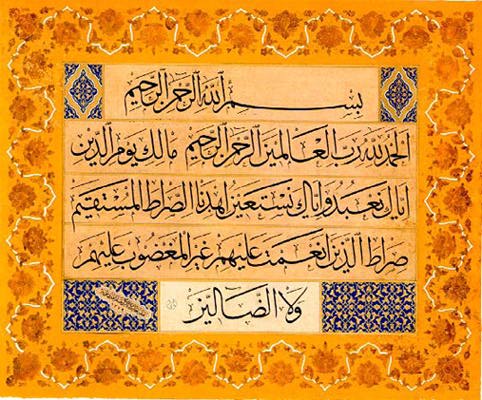|
|||||||||
|
Theology>>The Holy Quran>>Al-Fatehah |
|||||||||
|
|
(Click on the image to see actual size) Ink, gouache and gold on paper
Despite the abolition of Arabic calligraphy in 1923 by Mustafa Kamal Ata'turk,
the first President of The
Republic of Turkey, modern Turkish masters still are considered to be among
the leading practitioners of Arabic calligraphy in the Islamic world. This is not surprising when one
recalls that, from the late Middle
Ages onward, Ottoman masters were arguably the finest exponents of all
the calligraphic scripts devised by
the Arabs, the Persians and the Turkish themselves.
"In the name of God, The Compassionate, The Merciful; Praise be to God; the Cherisher and Sustainer of the Worlds; The Compassionate, The Merciful; Master of the Day of Judgment. Thee do we worship, and thine aid do we seek. Show us the straight way; The way of those on whom Thou hast bestowed Thy Grace, Those whose portion is not wrath, And who go not astray." This is written in Thuluth Jali (large format Thuluth) by Hamid al-Amidi (1891 -1982), who was born Musa Azmi, one of Turkey's most famous modern calligraphers. Hamid was a student of many famous calligraphers: Haci Hafiz Bey, Kamil Akdik, Hulusi Efendi and Ismail Hakki Altunbezer. Hamid worked as a teacher of calligraphy from 1910- until 1912, then as a cartographer at the Military College until 1918, before devoting himself full-time to the practice of his art. He copied the Holy Qur'an twice and did the inscriptions on the Sisli Mosque in Istanbul. The decoration is based on a traditional style of manuscript illumination. Source: http://www.islamicart.com |
||||||||



